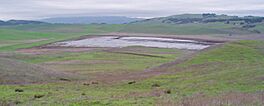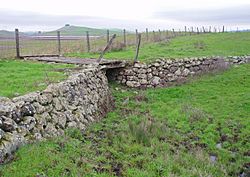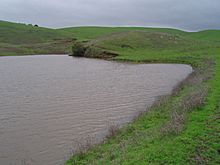Tolay Lake facts for kids
Quick facts for kids Tolay Lake |
|
|---|---|

View from south (February 2007)
|
|
| Location | Sonoma County, California |
| Coordinates | 38°12′33″N 122°30′50″W / 38.20917°N 122.51389°W |
| Primary outflows | Tolay Creek |
| Basin countries | United States |
| Surface area | 3,434 acres (1,390 ha) |
| Max. depth | 8 ft (2.4 m) |
| Water volume | 1,200 acre⋅ft (1,500,000 m3) |
| Shore length1 | 2.4 mi (3.9 km) |
| Surface elevation | 150 ft (46 m) |
| Islands | none |
| Settlements | Lakeville |
| 1 Shore length is not a well-defined measure. | |
Tolay Lake is a shallow freshwater lake located in southern Sonoma County, California, United States. This lake sits among the southern Sonoma Mountains. It is a very important place where Native American groups lived seasonally a long time ago.
In 2005, Sonoma County bought the entire lake and most of its surrounding land. They paid $18 million for it. The county plans to use this land as Tolay Lake Regional Park. This park will help protect nature and old historical sites. It will also be a place for people to visit and enjoy. Tolay Lake and its nearby areas are home to several golden eagles. Many rare, threatened, or endangered species also live here. These include the California red-legged frog, the Western pond turtle, and the Western burrowing owl.
Around 1850, European settlers changed Tolay Lake. They used dynamite to break a natural earth dam on the lake's south side. This was done to make more land for farming and grazing animals. After this, the lake often became almost dry in the summer. This is when the area gets the least rain. Another change was building an east-west earthen causeway. This causeway cuts the lake in half. It stops water from moving freely and separates groups of plants and animals.
Contents
Exploring Tolay Lake's Past

People have lived around Tolay Lake for at least 4,000 years. The Coast Miwok, Pomo, and other native Californians lived here seasonally. This lake was a special meeting place for different tribes. They believed the lake had healing powers. We know this because many ancient charmstones and arrowheads were found in the lake bed. These stones were brought from far away places, even Mexico. People believed throwing a stone into Tolay Lake could cure sickness or help crops grow.
Some of these old items are in a small museum at the park. Many others are in the Smithsonian Museum. So many old items were found that the lake was sometimes called Charmstone Lake.
Greg Sarris, who leads the Federated Indians of Graton Rancheria, said the lake was very sacred. He explained it was one of only three places in northern California where different tribes met for healing ceremonies. He also said the 1,000 charmstones found there are very important for his people and all native people in California.
In 1823, José Altimíra described the lake. He was the founder of Mission San Francisco Solano. He said the lake was named after a chief named Mr. Hukalaka Tolay. Altimíra estimated the lake's width and length, which was quite large.
How European Settlers Changed the Lake
In the mid-1800s, European settlers began farming in the Tolay Basin. They first damaged the natural earth dam at the lake's south end. This made the lake about half its original size. It allowed for more intense grazing and growing crops. Farming in the basin grew until about 1940. That's when the Cardoza family bought the land. They called their 1,737 acres (7.03 km2) property the Cardoza Ranch.
The Cardozas improved the ranch and owned it until 2005. They built many roads and fences. They also made well-crafted dry stone bridges and walls. These changes helped with cattle grazing, pumpkin farming, and other farm uses. In 2005, Sonoma County decided to buy the property. The Cardozas kept the large collection of charmstones found before the sale.
Sonoma County completed the purchase and made the land part of its park system. After studying the environmental impact and building park facilities, the park fully opened to the public in October 2018.
Understanding Tolay Lake's Water
The Tolay Lake basin is shaped like a bowl. It is surrounded by two ridges of the southern Sonoma Mountains. Tolay Lake gets its water from 18 different springs around its edges. Some of these springs turn into small streams that flow only part of the year. The biggest stream, Cardoza Creek, feeds the lake from the southeast. The lake's deepest point in winter is usually between four and eight feet (1 and 2 m). This depends on how much rain falls that season. Tolay Lake acts more like a large freshwater marsh. This is because it is shallow and has many water plants.
The lake's surface is about 150 feet (46 m) above sea level. The highest point in the area that drains into the lake is Cougar Mountain. It is about 800 feet (240 m) high. At the south end of the lake, Tolay Creek flows out almost all year. Tolay Creek then flows south into the Napa Sonoma Marsh. This marsh is next to San Pablo Bay, which is part of San Francisco Bay.
There are several ponds in the Tolay Lake Basin. Two large artificial ponds are separate from the lake. These ponds provide water for cattle. They also provide homes for some of the native amphibians and reptiles that live near Tolay Lake. An east-west earthen causeway also cuts the lake in half. This causeway stops water from moving well and separates plant and animal groups. The Tolay Lake Basin gets about 29 inches (740 mm) of rain each year.
Buildings and Culture at Tolay Lake
The Tolay Lake Basin has many well-preserved buildings. Most of these ranch buildings are from the first half of the 1900s. The Cardoza family built them as part of their working ranch. These buildings are important because they show an old architectural style. They also show what a complete Sonoma County ranch looked like and how it worked. The county is thinking about new ways to use some of these buildings. This would help preserve them and teach visitors about the park's history.
The county is also talking with Native American groups. These groups are descendants of the early tribes who used this land. These talks help make sure the lives of the prehistoric people are shown accurately and respectfully. This project also gives the Native American community a chance to grow and restore purple needle grass. This is California's official state grass. It is the best material for California Indian basket weavers to teach children the art of basket weaving.
Animals and Plants of Tolay Lake

Tolay Lake and the surrounding Sonoma Mountains have many different kinds of plants and animals. Historically, the area had lake or marsh environments, grasslands, and California oak woodlands. These woodlands were especially in the steep, high ravine areas. The lake itself has many different plants and animals. This includes several threatened and endangered species. Examples are the California red-legged frog and the western pond turtle.
Because of the many natural fresh water seeps, there is a lot of wildlife in the Tolay watershed. This includes the higher land areas. The valley is home to several important species. These include the burrowing owl, golden eagle, white-tailed kite, California horned lark, and the endangered tricolored blackbird. Tolay Lake is also one of only two places in the Bay Area that grows a special "moist prairie grass".
Bringing Tolay Lake Back to Nature
One main goal for Sonoma County in buying the Tolay Lake area is to restore its natural environment. They want to bring it back to how it was before European settlers arrived. In that earlier time, the lake would have been twice as big. Native marshes, grasslands, and even some forest areas would have been more common. This was before the harmful effects of cattle grazing and other intense agricultural practices. Sonoma County is asking for public ideas on how to restore the area. They also want to know how to balance this with allowing people to visit.
For the lake itself, there is a plan to make it bigger and deeper. They also want to improve how water moves around. There is also a chance to connect the two parts of the lake again. These parts are currently separated by the human-made earthen causeway. Removing this causeway would help connect plant and animal groups. It would also reduce the risk of local groups dying out.
The restoration of Tolay Lake is part of a bigger plan. This plan connects open spaces, protected lands, and wildlife areas in the region. These efforts link to the wetlands and uplands next to the San Pablo Bay marshes. These marshes make up half of all the wetlands that can be restored in the entire San Francisco Bay. Other nearby land purchases are also expanding this regional effort. These include Petaluma Marsh properties, Dickson Ranch, the New North Point site, and Skaggs Island. According to a group called Friends of Tolay Lake Park, this combined effort will greatly improve the chances of survival for endangered marsh and upland species. It will also help the overall health of San Francisco Bay.
One challenge for restoring the area is the nearby Infineon Raceway. This raceway creates a lot of noise. The possible effects of this noise on future wildlife have not been fully studied. Scientists know that some animal species are sensitive to human-made noise. They might avoid areas with a lot of noise.






